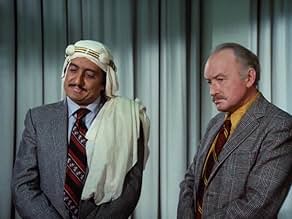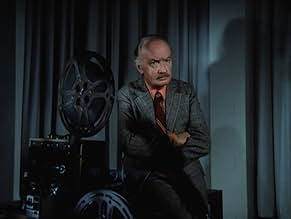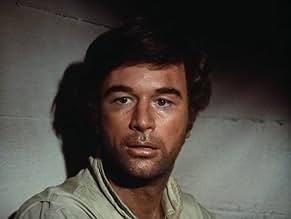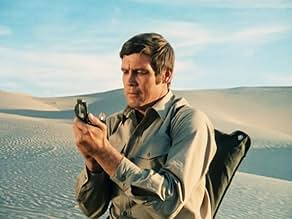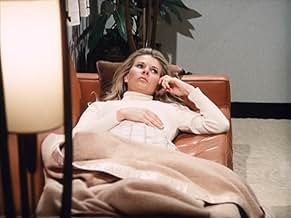IMDb RATING
6.9/10
5.3K
YOUR RATING
After an astronaut and test pilot is catastrophically mutilated in a test plane crash, he is rebuilt and equipped with nuclear powered bionic limbs and implants.After an astronaut and test pilot is catastrophically mutilated in a test plane crash, he is rebuilt and equipped with nuclear powered bionic limbs and implants.After an astronaut and test pilot is catastrophically mutilated in a test plane crash, he is rebuilt and equipped with nuclear powered bionic limbs and implants.
- Awards
- 1 nomination total
Charles Robinson
- Prisoner
- (as Charles Knox Robinson)
George D. Wallace
- General
- (as George Wallace)
Olan Soule
- Saltillo
- (as Olan Soulé)
Claire Brennen
- OSI Committee Member
- (uncredited)
Eddie Garrett
- Security Guard outside Steve's room
- (uncredited)
Storyline
Did you know
- TriviaDuring the opening sequence of the show, the crash shown is actual footage of a crash of the M2-F2 experimental lifting body that was part of the research that eventually led to the development of the space shuttle.
- GoofsThe "Factual Error" that Austin's human left arm should have been amputated to prevent incompatible balance produces an enormous character error if such had occurred. The friendship that is demonstrated between Austin and Dr. Wells would never allow the latter to amputate a healthy arm of his friend, whether it would be mechanically efficient or not. Further, Dr. Wells is portrayed as the kind of man not to violate his Hippocratic oath of "Do no harm" which such an amputation would be in contrast to.
- Quotes
Dr. Rudy Wells: I want to show you something, Steve. This is your arm.
Steve Austin: That's it, huh?
Dr. Rudy Wells: Um-hmn. We're rather proud of it. There's a manual that goes with it that has eight hundred and forty pages. I'll give you a copy.
- Alternate versionsRe-edited into two episodes of "The Six Million Dollar Man" for syndication. To pad out the story, scenes were added from The Bionic Woman (1975), The Bionic Boy (1976) and Dark Side of the Moon: Part 1 (1977).
- ConnectionsEdited from Lost Flight (1970)
Featured review
This is the first pilot of a five seasons series. The overall production values are satisfying enough to make the audience believe of that technological advancement miracle possible. This film is dry, raw, authentic, realistic, semi-documentary, existential and even depressing compared to the optimistic patriotic series thanks to the three actors' performance: Lee Majors, Martin Balsam and Darren McGavin. From the start, the character of Austin is defined: a rebel, a maverick, a dreamer, an individualistic test pilot who is a devotee of his past journey on the moon and doesn't follow the rules by the book -- he is late at his official appointment and replies sarcastically to a commanding officer -- Wells comments his attitude in this term: "Steve, you have a positive genius for antagonizing the wrong people". His best friend is, of course, Dr. Rudy Wells, a humanist, an innovator scientist-surgeon whose main concern is Austin's will to cope with his disability -- the name Wells may be a reference to utopist sci-fi writer H.G. Wells. The first waking up of Austin in Colorado's Research Center as an one-eyed, one-armed legless man, who tries to commit suicide during the night, is shocking, morbid and nightmarish -- it reminds me the bleakness of Dalton Trumbo's "Johnny Got his Gun". Austin is a self-conscious pragmatic man who wants to know the prize of his recovery: ruthless vulture ("I am not concerned by feelings"), cynical ("Accidents happen all the time. We just start from scrap"), mean ("Actually, we would prefer a robot -- 'robot' means a slave-worker in Czech --. A robot has no emotional need and responses. You're the optimun compromised"), crippled -- notice that he is also slightly disabled and walks with a stick -- O.S.O. head (scientifical department chief of the C.I.A.) Oliver Spencer sends him to his own death in the desert of Arabia on a suicidal mission where he receives another near fatal treatment. Spencer even asks Wells if he can let Austin in an indefinite artificial sleep until he needs him again. Austin refuses to be manipulated like a guinea pig, a "raw material" and reacts harshly: he slaps Spencer, turns down the hand of female Official Mrs. McKay and tells Spencer a curse before his forced electro sleep. The music of Gil Mellé is outstanding by creating the mood of technology, war and the character's psyche -- Austin is horrified by the view of his future artificial limbs, calls his friend Wells "Dr. Frankenstein, I presume?" after the bionic operation, he is uncomfortable with the ambiguity of the nurse's love impulse and feels monstrous owing to the woman's frightened behavior ("What are you?") after the rescue of her jeopardized son. The blend of experimental, distorted, atonal electronic style and a 1970's jazz helps the pace. Everything you want to know about Steve Austin lies in this rough pilot. Many episodes of the following series uses footages from that one and especially designer Jack Cole's main title. This is the work of Richard Irving who manages to produce and direct a clever adaptation of Martin Caidin's book. The film has an anti-government slant of that era via the Austin and Wells characters -- Austin's feeling about Spencer ("You're more of a robot than I am now") and Wells figure it out about Spencer's working plan for Austin in the Service: "Espionage, sabotage, assassination!" -- and, above all, the moral dilemma that is asked by the author of such advancement in the hands of the Power. There are subsequent themes tackled throughout the leading character: the loneliness and desperation, the inability to communicate, the fear of being abnormal and an outcast forever.
Details
- Release date
- Country of origin
- Language
- Also known as
- The Six Million Dollar Man: The Moon and the Desert
- Filming locations
- Production company
- See more company credits at IMDbPro
- Runtime1 hour 15 minutes
- Sound mix
- Aspect ratio
- 1.33 : 1
Contribute to this page
Suggest an edit or add missing content

Top Gap
By what name was The Six Million Dollar Man (1973) officially released in Canada in English?
Answer

